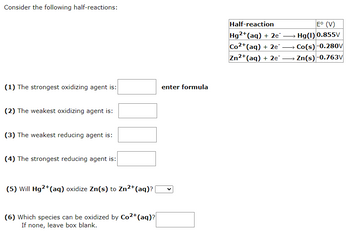A standard galvanic cell is constructed with Fe³+ | Fe2+ and Cr³+ | Cr half cell compartments connected by a salt bridge. Which of the following statements are correct? Hint: Refer to a table of standard reduction potentials. (Choose all that apply.) 0 As the cell runs, anions will migrate from the Fe³+ | Fe2+ compartment to the Cr³+ | Cr compartment. The anode compartment is the Fe3+ | Fe2+ compartment. In the external circuit, electrons flow from the Fe³+| Fe²+ compartment to the Cr³+ | Cr compartment. Fe3+ is reduced at the cathode. The anode compartment is the Cr³+ | Cr compartment.
A standard galvanic cell is constructed with Fe³+ | Fe2+ and Cr³+ | Cr half cell compartments connected by a salt bridge. Which of the following statements are correct? Hint: Refer to a table of standard reduction potentials. (Choose all that apply.) 0 As the cell runs, anions will migrate from the Fe³+ | Fe2+ compartment to the Cr³+ | Cr compartment. The anode compartment is the Fe3+ | Fe2+ compartment. In the external circuit, electrons flow from the Fe³+| Fe²+ compartment to the Cr³+ | Cr compartment. Fe3+ is reduced at the cathode. The anode compartment is the Cr³+ | Cr compartment.
Chemistry
10th Edition
ISBN:9781305957404
Author:Steven S. Zumdahl, Susan A. Zumdahl, Donald J. DeCoste
Publisher:Steven S. Zumdahl, Susan A. Zumdahl, Donald J. DeCoste
Chapter1: Chemical Foundations
Section: Chapter Questions
Problem 1RQ: Define and explain the differences between the following terms. a. law and theory b. theory and...
Related questions
Question
100%

Transcribed Image Text:A standard galvanic cell is constructed with Fe³+ | Fe2+ and Cr³+ | Cr half cell compartments connected by a salt bridge. Which of the following statements are correct?
Hint: Refer to a table of standard reduction potentials.
(Choose all that apply.)
As the cell runs, anions will migrate from the Fe³+ | Fe²+ compartment to the Cr³+|Cr compartment.
The anode compartment is the Fe³+ | Fe²+ compartment.
In the external circuit, electrons flow from the Fe³+ | Fe²+ compartment to the Cr³+ | Cr compartment.
Fe³+ is reduced at the cathode.
The anode compartment is the Cr³+1 Cr compartment.

Transcribed Image Text:A standard galvanic cell is constructed with Cl₂|CI and Cu²+ | Cu* half cell compartments connected by a salt bridge. Which of the following statements are correct?
Hint: Refer to a table of standard reduction potentials.
(Choose all that apply.)
0
In the external circuit, electrons flow from the Cu²+|Cu* compartment to the Cl₂|Cl compartment.
The cathode compartment is the Cl₂|CI compartment.
n Cu2+ is reduced at the cathode.
As the cell runs, anions will migrate from the Cu²+ | Cu* compartment to the Cl₂|CI™ compartment.
The cathode compartment is the Cu²+|Cu+ compartment.
Expert Solution
This question has been solved!
Explore an expertly crafted, step-by-step solution for a thorough understanding of key concepts.
This is a popular solution!
Trending now
This is a popular solution!
Step by step
Solved in 3 steps

Follow-up Questions
Read through expert solutions to related follow-up questions below.
Follow-up Question

Transcribed Image Text:Consider the following half-reactions:
(1) The strongest oxidizing agent is:
(2) The weakest oxidizing agent is:
(3) The weakest reducing agent is:
(4) The strongest reducing agent is:
(5) Will Hg2+ (aq) oxidize Zn(s) to Zn²+ (aq)? |
(6) Which species can be oxidized by Co²+ (aq)?
If none, leave box blank.
enter formula
Half-reaction
E° (V)
Hg2+ (aq) + 2e →→→Hg(1) 0.855V
Co2+(
2+ (aq) + 2e`. →→→Co(s)-0.280V
Zn2+ (aq) + 2e-
Zn(s) -0.763V
→
Solution
Knowledge Booster
Learn more about
Need a deep-dive on the concept behind this application? Look no further. Learn more about this topic, chemistry and related others by exploring similar questions and additional content below.Recommended textbooks for you

Chemistry
Chemistry
ISBN:
9781305957404
Author:
Steven S. Zumdahl, Susan A. Zumdahl, Donald J. DeCoste
Publisher:
Cengage Learning

Chemistry
Chemistry
ISBN:
9781259911156
Author:
Raymond Chang Dr., Jason Overby Professor
Publisher:
McGraw-Hill Education

Principles of Instrumental Analysis
Chemistry
ISBN:
9781305577213
Author:
Douglas A. Skoog, F. James Holler, Stanley R. Crouch
Publisher:
Cengage Learning

Chemistry
Chemistry
ISBN:
9781305957404
Author:
Steven S. Zumdahl, Susan A. Zumdahl, Donald J. DeCoste
Publisher:
Cengage Learning

Chemistry
Chemistry
ISBN:
9781259911156
Author:
Raymond Chang Dr., Jason Overby Professor
Publisher:
McGraw-Hill Education

Principles of Instrumental Analysis
Chemistry
ISBN:
9781305577213
Author:
Douglas A. Skoog, F. James Holler, Stanley R. Crouch
Publisher:
Cengage Learning

Organic Chemistry
Chemistry
ISBN:
9780078021558
Author:
Janice Gorzynski Smith Dr.
Publisher:
McGraw-Hill Education

Chemistry: Principles and Reactions
Chemistry
ISBN:
9781305079373
Author:
William L. Masterton, Cecile N. Hurley
Publisher:
Cengage Learning

Elementary Principles of Chemical Processes, Bind…
Chemistry
ISBN:
9781118431221
Author:
Richard M. Felder, Ronald W. Rousseau, Lisa G. Bullard
Publisher:
WILEY